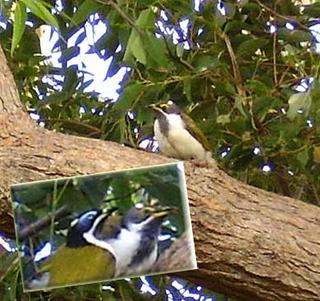The honeyeater and the sailor boy

In 1789, when the colony of New South Wales at Sydney Town, the first European settlement on the continent of Australia, was only a year old, one of the First Fleeters on HMS Sirius, 20-year-old Midshipman George Raper (b. September 19, 1769), painted a charming picture which he simply called 'Bird & Flower of Port Jackson', Port Jackson being the original name of Sydney Harbour. No British people had been there long enough to do much of the classification of flora and fauna, so the title itself gives a hint of the state of things in that year.
My third-rate photo shows the same bird here at Sandy Beach, in the backyard, ten paces from Esmeralda the Computer. I was alerted to the presence of several of them in the tree by their distinctive "Queet!" call.
What the indigenous people called this pretty bird I do not know, but today it is known as the Blue-faced honeyeater, or Entomyzon cyanotis. It was first described by Latham twelve years after the artist Raper executed his beautiful painting.
Wikipedia's useful article on honeyeaters tells us: "The honeyeaters are a large and diverse family of small to medium sized birds most common in Australia and New Guinea, but also found in New Zealand, the Pacific islands as far east as Hawaii, and the islands to the north and west of New Guinea known as Wallacia. Bali, on the other side of the Wallace Line, has a single species.
"Honeyeaters and the closely related Australian chats make up the family Meliphagidae. In total there are 182 species in 42 genera, roughly half of them native to Australia, many of the remainder occupying New Guinea."
The Blue-faced is a very adaptive bird, as it is found round here and way over in Western Australia, and many other parts of the country besides.
Zambia has a stamp of this pretty bird in its series of birds of the world, as does Australia (view), and this site has a short video.
George Raper had joined the Royal Navy when he was just 13, as a servant, and rose through the ranks, learning much about illustration, cartography, navigation, astronomy and seamanship in general. In 1791 he was one of the officers and men rescued by HMS Supply (another First Fleet vessel) after eleven months shipwrecked on a reef near Norfolk Island (he painted the rescue too), for which the officers were court-martialled but honourably acquitted in Britain in 1792.
After his adventures in the South Seas he returned to Britain no doubt with many tales and wonders to tell the disbelieving friends and family, and was placed in charge of a cutter, the Expedition on July 20, 1796. Lieutenant Raper died in 1797, only about 28 years of age. In his will, he asked for all his papers to be put "in my Painting Case and delivered to my dearest and beloved mother".



















0 Comments:
Post a Comment
<< Home